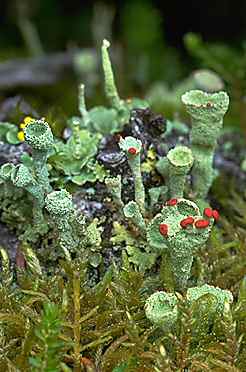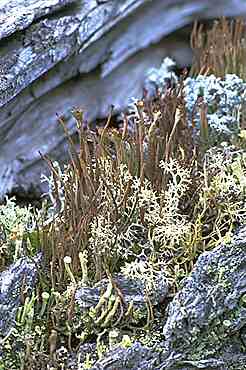Introduction to Lichens
 In 1867 Simon Schwendener, a Swiss biologist, discovered that lichens are
dual organisms composed of a fungus and its algal partner. Later, biologists
discovered that a third organism, a cyanobacterium such as Nostoc,
sometimes becomes part of the lichen, creating a three way symbiosis, as
in Peltigera. Some scientists say that
the fungus parasitizes the algae and others say that the association is
symbiotic or mutually beneficial. Others say that the lichen should not
be called an "organism" at all because it is really an ecosystem
in miniature.
In 1867 Simon Schwendener, a Swiss biologist, discovered that lichens are
dual organisms composed of a fungus and its algal partner. Later, biologists
discovered that a third organism, a cyanobacterium such as Nostoc,
sometimes becomes part of the lichen, creating a three way symbiosis, as
in Peltigera. Some scientists say that
the fungus parasitizes the algae and others say that the association is
symbiotic or mutually beneficial. Others say that the lichen should not
be called an "organism" at all because it is really an ecosystem
in miniature.
At any rate, lichens are some of the most adaptable organisms known and
can live in deserts, tropical jungles, arctic tundra, on rocks, inside of
rocks (endolithic), on bark (corticolous), on soil (terricolous), almost
anywhere. Despite their adaptability, lichens generally require pure air and water
to live and can be used to monitor evironmental air quality. Alaska has
a profusion of lichens common to the boreal forest and arctic-alpine tundra
such as the various Cladonia and Cladina species shown here.
To see more, click on a lichen from the list to the left.
Despite their adaptability, lichens generally require pure air and water
to live and can be used to monitor evironmental air quality. Alaska has
a profusion of lichens common to the boreal forest and arctic-alpine tundra
such as the various Cladonia and Cladina species shown here.
To see more, click on a lichen from the list to the left.